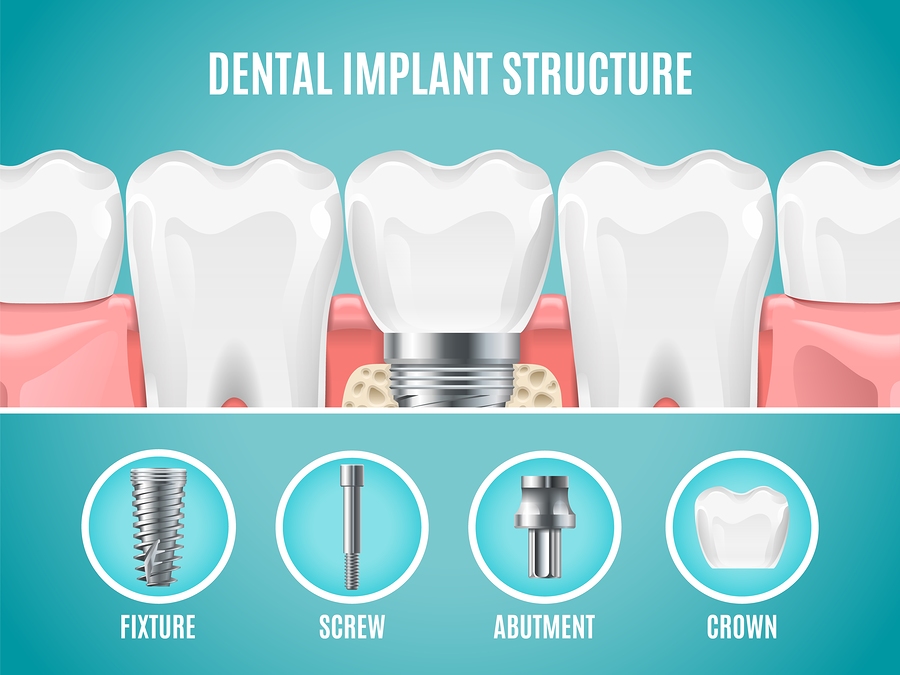The Facts About Dental Sense Uncovered
The Facts About Dental Sense Uncovered
Blog Article
Getting The Dental Sense To Work
Table of ContentsThe Buzz on Dental SenseThe Ultimate Guide To Dental SenseEverything about Dental SenseGetting The Dental Sense To Work
are medical tools surgically implanted into the jaw to bring back an individual's capacity to chew or their look. They offer support for fabricated (phony) teeth, such as crowns, bridges, or dentures. When a tooth is lost because of injury or illness, an individual can experience issues such as fast bone loss, defective speech, or modifications to chewing patterns that lead to pain.Dental implant systems contain a dental implant body and dental implant abutment and might likewise consist of an abutment fixation screw. Kids dental. The dental implant body is operatively put in the jawbone in location of the tooth's origin. The dental implant abutment is typically attached to the dental implant body by the joint addiction screw and extends via gum tissues into the mouth to support the attached artificial teeth
(https://allmyfaves.com/dentalsense1?tab=Dental%20Sense)Framework of The Oral Implant System choosing oral implants, speak with your dental copyright about the potential benefits and dangers, and whether you are a candidate for the procedure. Points to consider: Your overall health and wellness is a crucial consider figuring out whether you are a great candidate for oral implants, for how long it will certainly require to recover, and how much time the dental implant might remain in place.
Smoking cigarettes might impact the recovery process and decrease the long-term success of the implant. The healing process for the implant body may take a number of months or longer, during which time you generally have a temporary abutment in area of the tooth. the dental implant procedure: Thoroughly follow the dental hygiene instructions provided to you by your dental service provider.
The Dental Sense Diaries
Implant failure can lead to the demand for an additional operation to deal with or replace the implant system. Restores the capacity to chew Recovers aesthetic appearance Assists maintain the jawbone from shrinking because of bone loss Protects the health of the bordering bone and gum tissues Aids maintain nearby (nearby) teeth secure Improves top quality of life Damages to bordering natural teeth throughout implant placement Injury to the surrounding cells throughout surgery, such as sinus opening Injury throughout surgical procedure (for instance, fracture of bordering jawbone) Insufficient function, such as really feeling like the teeth do not bite with each other usually An experience that the tooth is loose or turning in position resulting from an abutment screw loosening Implant body failing (looseness of the dental implant body) as a result of systemic infection, which might be more probable in patients with uncontrolled diabetes due to neighborhood infection in bone and periodontals supporting the implant body because of delayed recovery, which may be more likely in individuals who smoke Problem cleaning up the gums around the dental implant, resulting in poor dental hygiene Unattended gum illness Post-surgical tingling because of nerve impingement or damage Constantly inform health care providers and imaging service technicians that you have oral implants before any magnetic resonance imaging (MRI) or x-ray procedures.
FDA is not knowledgeable about any type of damaging occasions reported for MRI or x-ray procedures with oral implants. Oral implants systems are normally constructed from materials that adhere to international agreement standards of the International Company for Standardization (ISO) or ASTM International. These requirements have information of what makes a risk-free material.

An oral implant is a framework that changes a missing tooth. With screw-like devices, the cosmetic surgeon inserts a dental implant right into the jawbone, and it functions as an anchor for an artificial tooth, called a crown. A gadget called a joint connects the artificial tooth to the oral implant. The crown is customized to fit the individual's mouth and match the shade of their webpage teeth.
Some Ideas on Dental Sense You Need To Know
Some people are not qualified for oral implant surgical treatment. It is for oral specialists to operate individuals with: intense illnessuncontrollable metabolic diseasebone or soft cells disease or infectionIf these concerns are settled, an individual can have the surgical procedure. In, dental specialists avoid operating on individuals with: If individuals with any one of the above go through oral implant surgical treatment, there is a greater risk of the implant failing.

Dental implant surgery is a personalized procedure. It's not the very same for everyone. Yet the complying with provides a general introduction of what you can anticipate your dental expert, dental cosmetic surgeon, periodontist or prosthodontist to do: Position the dental implant operatively. Give you time to recover. Affix the post and final crown, bridge or denture.
Next, your doctor will meticulously place the oral implant right into your jaw. Lastly, your doctor will certainly reposition your gum tissues and shut the laceration with stitches. If your implant is near the front of your mouth, your dental professional will certainly make a temporary tooth for you to put on until you heal. This way, you won't have a gap in your smile while you recover.
The Only Guide to Dental Sense
Throughout the healing stage, your jawbone ought to fuse to the dental implant. This process can take anywhere from 3 to 9 months.
As soon as your implant heals, your dental professional can connect the joint (tiny port article) and your last restoration (crown, bridge or denture). This generally takes concerning one hour to finish and may call for a second small surgical treatment. You should not feel any type of pain during your dental implant procedure because your company will use medication to numb your gum tissues.
Report this page